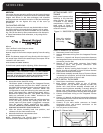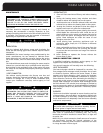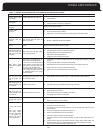
19
MODEL F80A
ADJUSTING BLOWER SPEEDS
If the blower speeds require adjusting, follow these steps:
1. Remove the blower compartment door
.
2. Access the motor electrical wiring.
The blower speed is changed at the integrated furnace
control. Remove the wire from the "HEAT" terminal of
the 50A55-250 integrated furnace control and plug in the
desired wire on the HEAT" terminal. When this
configuration is used, the following color codes are used:
Black - High Speed, Blue - Medium-High Speed, Yellow -
Medium-Low Speed, and Red - Low Speed. The unused
leads are connected to the “PARK” terminals on the
50A55-250 integrated furnace control.
IMPORTANT: If the heating speed and cooling speed are
to be the same, remove the cooling lead from the
control, tape it off, then install a “piggyback” connector
from the control “HEA
T” terminal to the “COOL”
terminal. UNDER NO CIRCUMSTANCE MAY TWO MOTOR
WINDINGS BE POWERED SIMUL
T
ANEOUSLY.
3. Slide the blower assembly back into position, and
refasten with the sheet metal screws.
4.
Reinstall the blower compartment door
.
5. Recheck temperature rise.
NOTE: Temperature rise should always be rechecked
whenever blower speed changes are done.
HOW TO REMOVE THE BLOWER
1. Disconnect power from furnace.
2. Remove thermostat wiring from the integrated furnace
control.
3. Remove L1, Neutral and Ground connections between
the integrated furnace control and the Furnace electrical
connection junction box.
4. Remove 12 pin male molex connector from female
connection point, and ground connection from
integrated furnace control.
5. Unscrew 2 blower housing bolts located in the front
blower shroud as indicated in figure 12 below. Remove
front blower shroud from furnace.
6. Slide blower assembly towards front of furnace. Blower
is mounted on rail system, and will slide forward about
10 inches before blower is clear of rails.
HOW TO INSTALL THE BLOWER
1. Place blower into blower compartment.
2. Keep blower assembly tight to top of blower
compartment. Line up blower assembly to slide into
blower rails. Push blower assembly towards back of
furnace ensuring blower assembly is correctly placed in
blower rails. Insert blower shroud on the front of the
blower housing. Insert blower housing bolts and tighten.
3. Connect thermostat wiring to the integrated furnace
control.
4. Connect L1, Neutral and Ground connections between
the integrated furnace control and the furnace electrical
connection junction box.
5. Connect 12 pin male molex connector to female
connection point, and ground connection to the
integrated furnace control.
6. Turn on power to the furnace.
S
ETTING BLOWER "OFF"
TIMINGS
B
oth control systems allow
flexibility in the FAN OFF
delay function. The control
is located in the blower
compartment. Follow the
s
ame steps as listed in
Adjusting Blower Speeds to
access the control.
WARNING
DISCONNECT THE ELECTRICAL SUPPLY TO THE FURNACE
BEFORE ATTEMPTING TO CHANGE THE BLOWER SPEED.
FAILURE TO DO SO COULD RESULT IN ELECTRICAL SHOCK
RESULTING IN PERSONAL INJURY OR LOSS OF LIFE.
SEC.SW 1SW-2
60ONON
90OFF ON
120*ON OFF
1
80OFF OFF
DIP SWITCH
HEAT "OFF" DELAY
Figure 11: 50A55-250 Dip Switch Settings
These dip switches
control the “Blower
off” timing
Figure 12: Blower bolts
Bolts
Where:
Cfm is airflow in cubic feet per minute
∆T is the temperature rise
Bonnet output is the furnace output capacity from the rating
plate.
NOTE: The bonnet output will vary directly with the input. If
the actual input is below the stated input, the output will be
reduced in the same ratio.
AIRFLOW
For proper furnace operation, airflow over the heat exchanger
i
s of utmost importance. Insufficient airflow accelerates metal
f
atigue and failure in the heat exchanger and excessive
airflow promotes accelerated corrosion of the heat exchanger.
I
MPORTANT: Do not bypass this step of the start up
procedures.
CALCULATING AIRFLOW
There are circumstances where it may be desirable to know
the airflow delivery through the duct system, such as when
e
stimating the amount of airflow available for air condition-
ing. This can be done by direct measurement with electronic
or sloped manometers and velometers, or by using the for-
mula below.


















